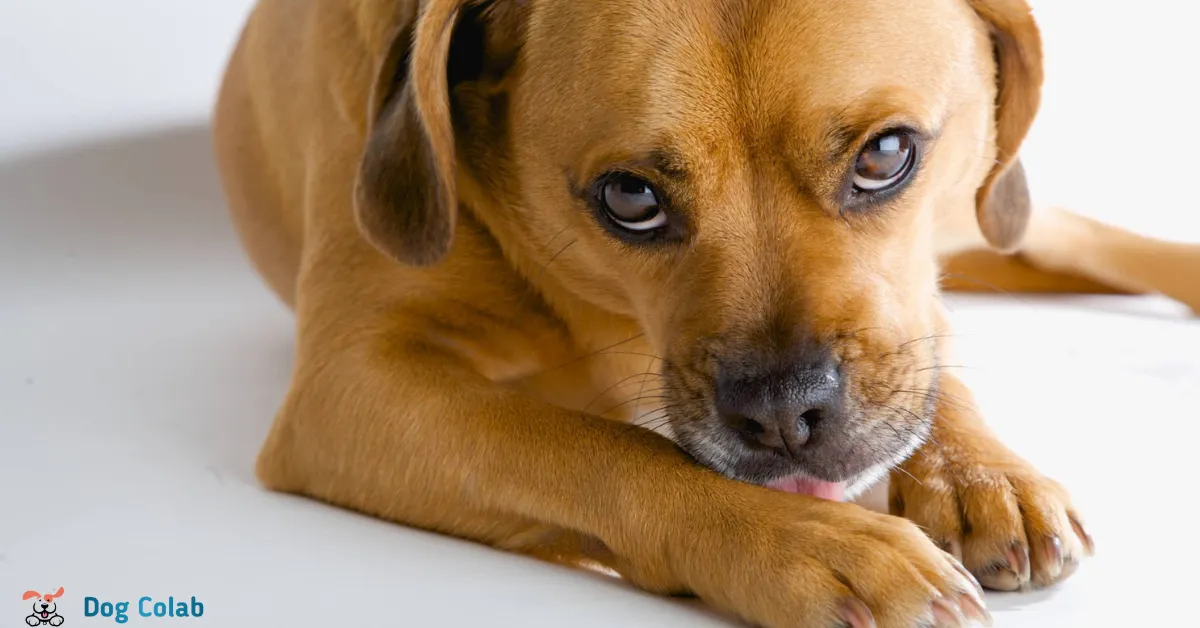Preventing a dog from licking a wound on its paw is essential for ensuring a timely and infection-free healing process. If left untreated or exposed to excessive licking, can lead to complications and delayed recovery. Dogs have a natural tendency to lick their wounds, which might seem like a caring gesture but can actually hinder the healing process.
Excessive licking can introduce bacteria, delay wound closure, and potentially worsen the injury. In this blog post, we will discuss the strategies for how to keep dog from licking wound on paw that help to promote a safer and faster recovery.
Why Do Dogs Lick Their Wounds?
Dogs lick their wounds for a variety of reasons, but the primary motivation behind this behavior is likely a combination of instinctual and physiological factors. Here are a few reasons why dog lick their wounds.
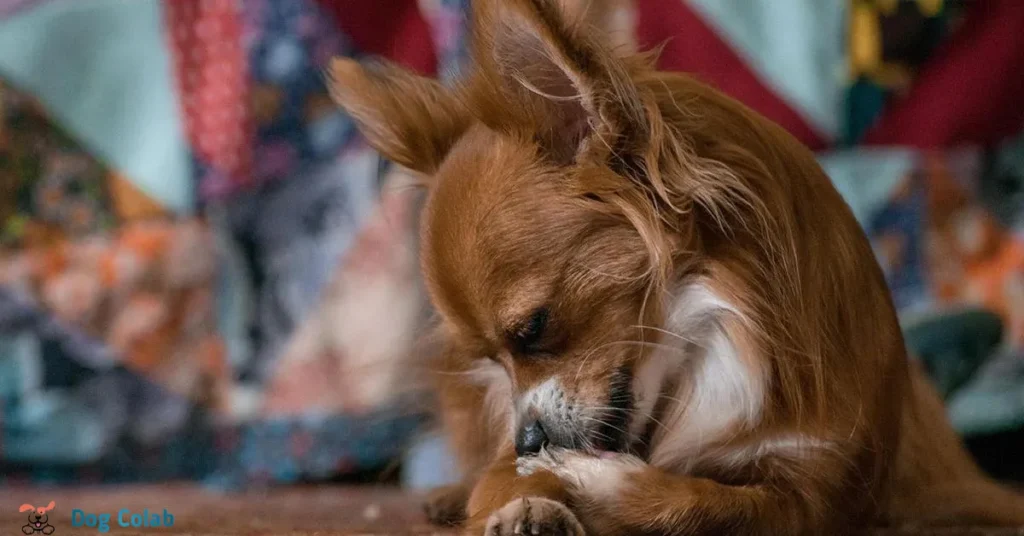
1. Cleaning and Disinfecting
Dog licking is a natural grooming behavior. When they have a wound, they might instinctively lick it to clean the area and remove dirt, debris, and potentially harmful substances that could cause infection.
2. Pain Relief
Licking can stimulate the release of endorphins, which are natural pain relievers. This behavior might help alleviate discomfort and provide some relief from the pain associated with the wound.
3. Moisture
Saliva contains enzymes and proteins that can help promote wound healing by breaking down dead tissue. Additionally, licking can provide a source of moisture, which can be beneficial for the wound-healing process.
4. Comfort and Soothing
Dogs might find the act of licking to be soothing and comforting. It’s a self-soothing behavior that they engage in when they’re stressed, anxious, or in pain.
What Happens If Dog Licks Wound?
If a dog licks a wound, there can be both positive and negative effects, depending on the extent and duration of the licking. Here’s what can happen when a dog keeps licking wound.
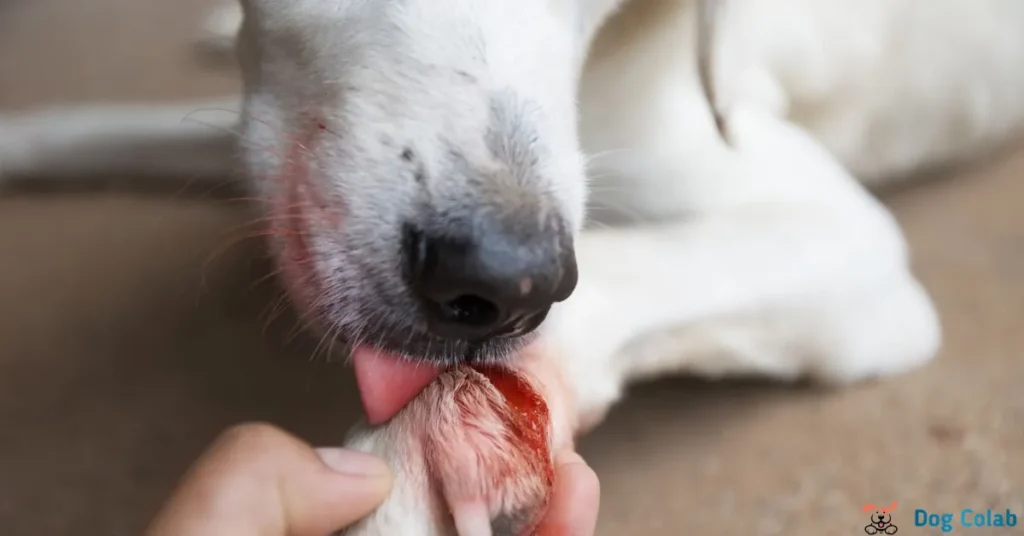
Positive Effects
- Cleaning: Initially, licking can help clean the wound by removing dirt, debris, and foreign particles. A dog’s tongue is rough and can act like a natural scrubbing mechanism.
- Moisture: Saliva contains enzymes and proteins that can help break down dead tissue and promote wound healing. The moisture from licking can also help keep the wound from drying out excessively.
- Pain Relief: Licking can stimulate the release of endorphins, which are natural pain relievers. This can help the dog feel more comfortable and alleviate some of the pain associated with the wound.
Negative Effects
- Infection: A dog’s mouth is not sterile, and the constant licking can introduce bacteria from the mouth into the wound. This can increase the risk of infection, delaying the healing process.
- Irritation: Excessive dog licking can irritate the wound, causing further inflammation and slowing down the healing process. It can also lead to a condition known as “lick granuloma,” where the wound becomes a chronic, non-healing sore due to continuous licking.
- Prevention of Scab Formation: Licking can prevent the formation of a protective scab over the wound. A scab is a natural barrier that helps protect the wound from external contaminants and aids in the healing process.
- Worsening the Wound: Intense licking can disrupt the wound’s healing process, potentially leading to delayed healing, increased scarring, and complications.
How To Keep Dog From Licking Wound on Paw?
Preventing a dog from licking a wound on its paw can be challenging, as dogs are persistent and determined in their behaviors. However, you can try several strategies how to keep a dog from licking wound.
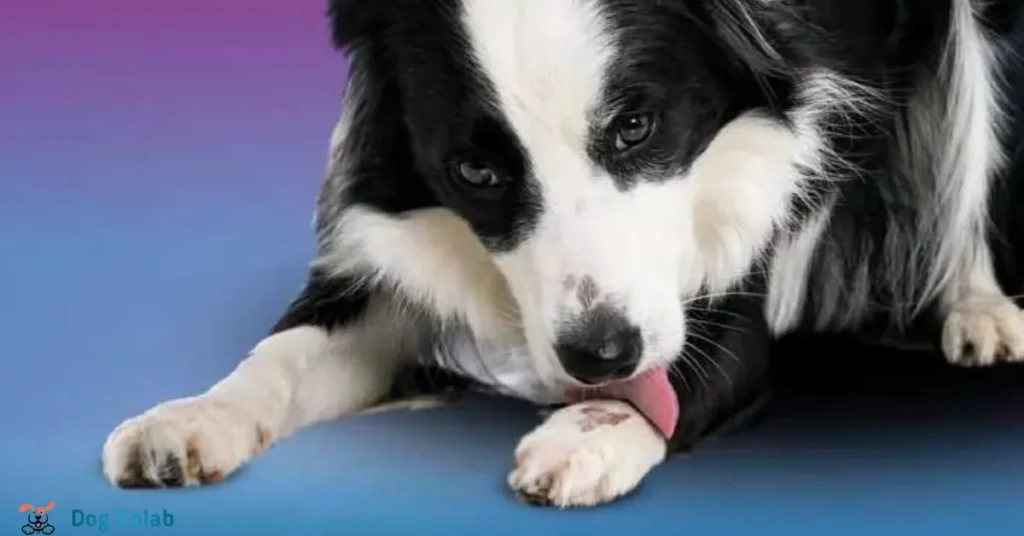
1. Elizabethan Collar (E-Collar)
Also known as a cone, an E-collar is a plastic cone-shaped device that goes around your dog’s neck, preventing them from reaching its wound with its mouth. While it might seem uncomfortable for the dog, it is an effective way to stop dog licking wound.
2. Covering the Paw
If the wound is on a paw, you can try covering the paw with a dog bootie or a bandage. Make sure the covering is secure enough that the dog can’t easily remove it, but not too tight to restrict blood circulation.
3. Bandages
Applying bandages or dressings to the wound can help protect it from licking. However, keep in mind that dogs can sometimes be skilled at removing bandages, especially if the wound is on a paw. To avoid restricting blood flow, ensure that the bandage is secure but not too tight.
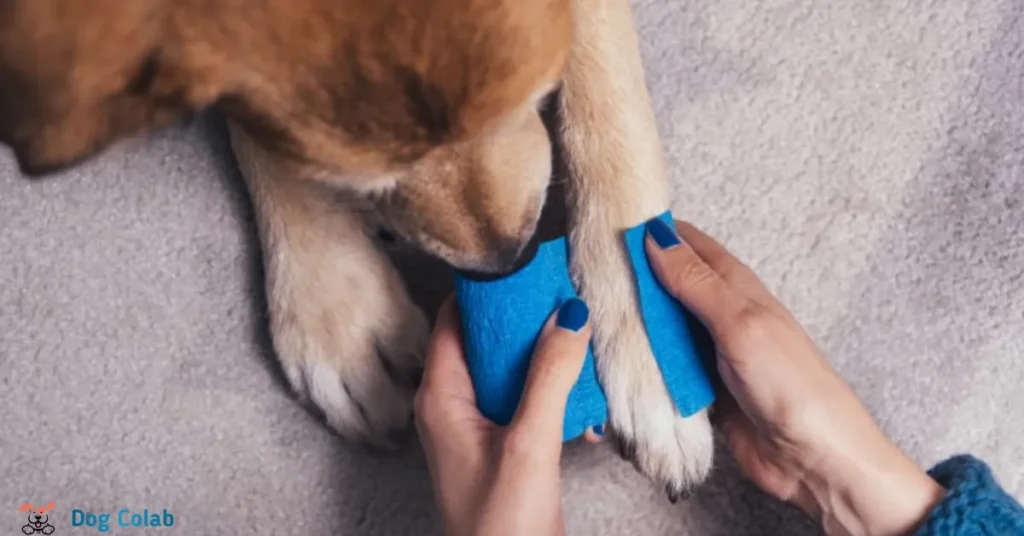
4. Booties
Dog booties can be a good option if the wound is on the paw. Booties cover the paw and wound, making it difficult for the dog to lick. Make sure to choose booties that fit properly and are comfortable for your dog to wear.
5. Positive Distraction
Keep your dog engaged in positive activities and provide them with toys, puzzles, or activities that mentally stimulate them. A distracted dog is less likely to focus on licking their wound.
6. Training
Use positive reinforcement training techniques to teach your dog a “leave it” or “no licking” command. Reward them when they obey the command and refrain from licking the wound.
7. Consult a Veterinarian
If your dog’s wound is severe, not healing, or becoming infected despite your efforts, consult a veterinarian. They can provide guidance on wound care and suggest additional strategies to prevent licking.
Read More:- How to treat collar sores on dogs.
Home Remedy To Keep Dog From Licking Wound
There are a few home remedies you can try to deter your dog from licking a wound. Keep in mind that these remedies might not work for all dogs, and it’s important to monitor your dog’s behavior and the effectiveness of the remedy.
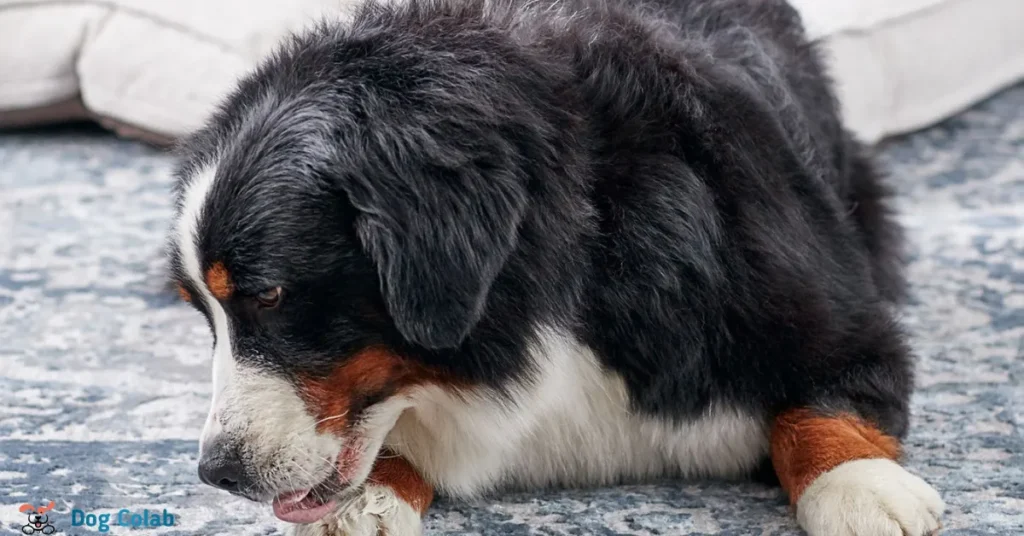
If the wound is serious or not improving, it’s always best to consult a veterinarian for professional guidance. You can consider the following home remedies.
1. Petroleum Jelly or Coconut Oil
Applying a small amount of petroleum jelly or coconut oil around the wound can create a barrier and make the wound less accessible for licking. However, be cautious about using too much, as it can soften bandages and interfere with wound healing.
2. Homemade Taste Deterrent Spray
Certainly, here’s a step-by-step guide to creating a homemade taste deterrent spray to discourage your dog from licking wounds.
Ingredients
- 2 cups of apple cider vinegar (or substitute with lemon juice)
- 1 cup of white vinegar
Equipment
- Empty spray bottle
Prepare the Mixture
- Pour 2 cups of apple cider vinegar (or lemon juice) into an empty spray bottle.
- Add 1 cup of white vinegar to the spray bottle.
Mix Thoroughly
- Secure the spray nozzle on the bottle.
- Shake the bottle well to ensure that the apple cider vinegar and white vinegar are thoroughly mixed.
Test with Your Dog
- Before applying the mixture to your dog’s wound, it’s important to determine if your dog is averse to the taste.
- Apply a small amount of the mixture onto a tissue or a cotton swab.
- Gently place the tissue or swab in your dog’s mouth, allowing them to taste the mixture.
Observe Your Dog’s Reaction
- If your dog spits out the tissue or swab and seems to dislike the taste, this indicates that they may find the taste deterrent unappealing.
Apply to the Wound Area
- If your dog’s reaction is negative, you can then consider applying the taste deterrent spray to the wound area to discourage licking.
Monitor and Reapply as Needed
- Apply the taste deterrent spray as needed to the wound area to discourage licking.
- Monitor your dog’s behavior and the healing process to ensure that the wound is not being further irritated.
You may also be interested in:- Can my dog be allergic to seresto collar.
How To Stop Dog Licking Wound Without Collar?
If you’re looking how to stop dog licking wound without collar, there are a few alternative approaches you can try. Here are some methods to consider.

1. Positive Distraction
Engage your dog in activities that keep their mind occupied and discourage them from focusing on the wound. Offer interactive toys, play games, or provide puzzle feeders to redirect their attention away from the wound.
2. Training and Commands
Teach your dog commands like “Leave it” or “Stay” to help them understand that they should not lick the wound. When they correctly follow these commands, treat them.
3. Covering the Wound
If the wound is on a limb, you might be able to cover it with a lightweight, breathable fabric such as a clean sock (with the toe cut off) secured with medical tape. This can act as a barrier and prevent direct access to the wound.
4. Regular Supervision
If none of the above methods are working, consider supervising your dog closely whenever they are near the wound. This allows you to redirect their attention if they attempt to lick.
Conclusion “How To Keep Dog From Licking Wound On Paw”
In preventing dogs from licking wounds on their paws, various methods can be employed to ensure their well-being and promote proper healing. Utilizing e-collars, bandages, booties, clothing, and taste deterrents can effectively discourage licking while providing comfort. Selecting the most suitable approach based on the dog’s behavior, the wound’s location, and the owner’s preferences is essential.
By employing these methods and closely monitoring the healing process, owners can help their furry companions recover without the potential complications caused by excessive licking.
NOTE:- More information can be found by clicking this link.
FAQs
1. Can I put a shirt on my dog instead of a cone?
Yes, you can use a shirt as an alternative to a cone for your dog. Dog shirts can help prevent them from licking or scratching a wound, but monitor them to ensure they don’t remove it.
2. How can I heal my dogs wound fast at home?
Make sure the wound is clean and dry, and prevent your dog from licking or scratching it. However, it’s best to consult a vet for proper guidance, as they can provide tailored advice for your dog’s specific situation.
3. Can I put Vaseline on my dogs paws?
Yes, you can apply a small amount of Vaseline to your dog’s paws to help moisturize and protect them from harsh conditions. However, be cautious not to apply too much, as dogs may lick it off. Consult your veterinarian for proper paw care and suitable pet-safe products.
4. What taste do dogs hate to stop licking?
Most dogs dislike the taste of bitter or citrus flavors. These tastes often deter them from licking surfaces. Products like bitter apple spray or lemon-based solutions can discourage excessive licking. However, individual preferences may vary, so it’s important to find a taste that works for your specific dog.
5. What is a natural antiseptic for dogs?
Tea tree oil, diluted in water, can serve as a natural antiseptic for dogs. However, it’s essential to use it cautiously as some dogs can be sensitive to it. Always consult a veterinarian before using any natural remedies on your pet to ensure their safety and proper usage.
